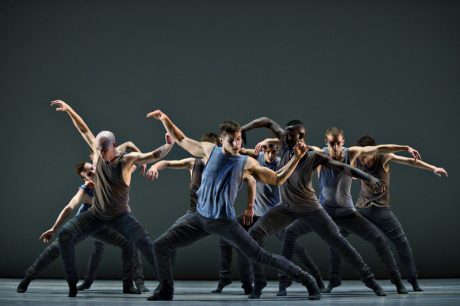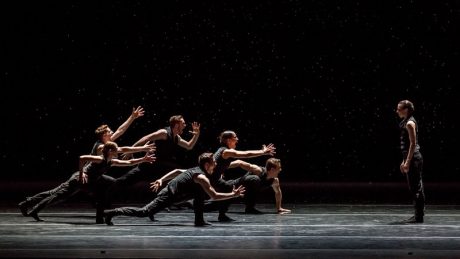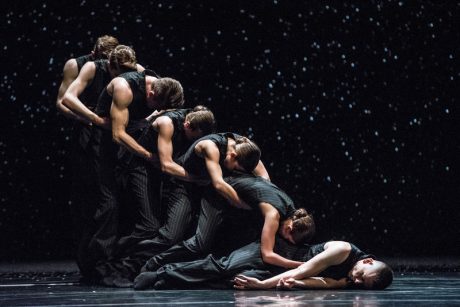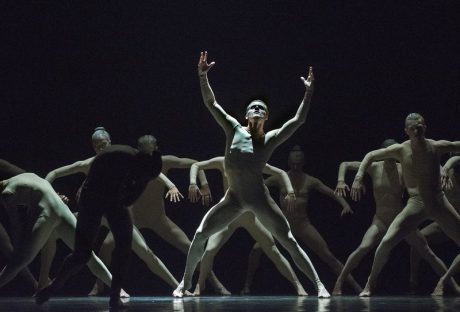Review: Ballet British Columbia at The Lowry
| 21st March 2018
Vancouver-based Ballet British Columbia is described as a “contemporary ballet company”. While for traditional audiences this might sound like an oxymoron, the Canadian company showed last night at the Lowry, that contemporary creation with a ballet heritage is a recipe for success.
The programme, shown as part of the company’s first UK tour, started with 16 + in a room, choreographed by artistic director Emily Molnar. Her idea is intriguing: what happens if you put 16 people in a room and start tipping it from one side to the other? The curtain rises on a stripped down and brightly lit stage, where the dancers appear, still at first, but soon start moving, as if they were responding to a constant shift of balance. The choreography is risky, dancers slide from one side of the stage to the other, readjust, keep going. It uses classical lines and the women wear pointe shoes, but the movement is pushed to its limits, on the edge of falling before recovering. There is a close attention to detail, and the dancers move with precision and energy at exhilarating speeds.

Ballet British Columbia in 16 + in a room
The second half of the piece is calmer; the stage is dark with a completely black backdrop. Two men in particular execute a perfectly synchronised duet with effortless fluidity. The electronic music by German composer Dirk Haubrich is not very inventive but serves the movement adequately without disturbing it. The costumes, dark-grey trousers with a loose T-shirt for the men and a tight top for the women, give a casual look to the piece.
The issue with a work like this is that one needs to analyse and understand the choreography to be able to appreciate it entirely. It feels a bit like a piece made by dancers, for dancers. It has an extremely intelligent approach to the movement, but one might need to see it several times before enjoying it to its full potential.

Ballet British Columbia in Solo Echo
The second piece, Solo Echo, by Canadian choreographer Crystal Pite, is the highlight of the evening. Pite is acclaimed worldwide as one of today’s most talented choreographers; she has her own company and has created works for the biggest institutions in the world. This piece, created in 2012, was inspired by a poem by Mark Strand, Lines for Winter. Winter is suggested by a moonlit snowfall in the background which gives a feeling of peaceful infinity, as it goes on undisturbed and the space beyond it looks like an endless dark sky. Seven dancers move to two of Johannes Brahms’s Sonatas for Cello and Piano, which give a poetic and intimate atmosphere to the whole piece. The choreography is at first full of energy and enthusiastic. Typical features of Pite’s work are visible – every gesture makes sense and comes from a clear intention that drives both shapes and energy; each movement has a cause and a consequence.

Ballet British Columbia in Solo Echo
The second part is more theatrical: the dance creates images with a certain sense of story; relationships between the dancers are built, and change. Dancers struggle between themselves – but is it seven people struggling with each other, or an internal battle within one’s mind? Men and women seem at times frozen in the middle of a race, reaching for something, or hanging on to someone, in a still picture underlined by Brahms’s powerful score. Pite’s ability to suggest emotion only through abstract dancing and her unique choreographic language makes her a genius of her own kind – and the audience was thrilled.
The final piece, Bill, choreographed by Sharon Eyal and Gai Behar, is an oddity which leaves one perplexed. The 18 dancers are wearing full-body, tight, light beige leotards, and their hair is painted the same; the changing lights show them in different colours. Provocative solos alternate with group sections where the dancers, in their androgynous second-skin outfits, move in a robotic tribal manner. Sometimes the solos look like a satire of pop culture: one man seems to be in an arcade game, another catwalks and poses like a model. They look at the audience, tease them – or are they looking at themselves in a mirror? Some moments are astonishing – like when the most petite woman of the company screams “magic” in an authoritative voice, as if expecting everyone to follow suit (and they do). The music goes from pop songs to heavy electronic beats. This piece is bizarrely overwhelming, and its intensity, due mostly to the stage presence and energy of the dancers, leaves the spectator exhausted – in a bad or a good way, as people’s perceptions differ.

Ballet British Columbia in Bill
Altogether, this programme is the opportunity to discover this high-profile company, and director Emily Molnar is certainly making successful artistic choices for her dancers. Let’s hope we will see more of them in the future.
Ballet British Columbia are performing at The Lowry until tonight, then in Bradford until Saturday.
For tickets and more information, visit The Lowry website or the Alhambra Theatre website.
